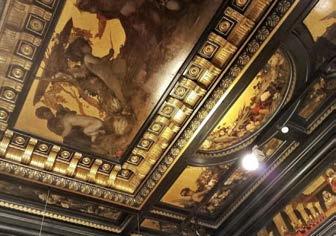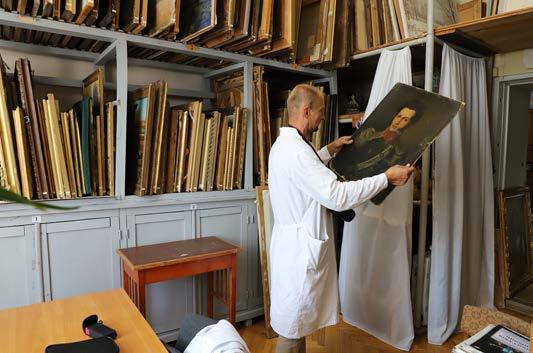ALIPH and
the Khanenko Museum
Preserving a page of our common memory, together

 © Kharkiv Museum
© Kharkiv Museum
Since the first days of the conflict, ALIPH has been committed to support the Ukrainian people and cultural heritage professionals in their efforts to protect the unique heritage that forms part of their identity and provides a source of wonder for all.
1
The Khanenko Museum: a story of passion and a witness to history

2

3
© Khanenko Museum
The Khanenko Museum’s history is a tale of passion – a passion for art from its creators and for preservation from its staff.



It began in the 1870s, when the entrepreneur Bohdan Khanenko (18491917) married Varvara Tereshchenko (1852-1922), a staunch defender of Ukrainian artisanry and the eldest daughter of a businessman and collector. The young couple, passionate about art, began collecting paintings, sculptures, and objects, with the dream of one day opening a museum in their own home in Kyiv. Their stately mansion was built at the end of the 19th century, boasting beautiful woodwork and sumptuous décor, and designed to display their rich
art collection. In 1918, the year following her husband’s death, Varvara Khanenko requested in a deed of gift that the Ukrainian National Academy of Science take over the art collection, house, and library.

4
As soon as it opened to the public, history took its toll on the museum. In June 1919, the Bolshevik government nationalized the Khanenko family property. That same year, a State Museum of Art was established with the Khanenko art collection and located in their former residence, even though the museum itself lost the name of its founders. During the Second World War, even while its most precious works were evacuated, the part of the collection that remained in Kyiv was looted by the Nazis.


It wasn’t until 1999 that the museum regained the name of its founders and was renamed “The Bohdan and Varvara Khanenko National Museum of Arts.”

The museum and its collections bear witness to the turbulent history of a country while simultaneously revealing the many facets of the world’s richness.
In 2004, a permanent gallery was opened to display 6th- and 7th-century Byzantine icons from Sinai; today, the museum holds one of the most important collections of European, Asian, and ancient art in Ukraine.

5
All pictures © Khanenko Museum

6

7
© Khanenko Museum
ALIPH and the Khanenko Museum: safeguarding a part of our shared memory
But history repeated itself, and at the end of February 2022, in the early hours of the war, sirens sounded in Kyiv. At the same time, in the center of Europe, in Geneva, ALIPH was mobilized to help Ukrainian heritage and its professionals.
Once again, with the utmost devotion, museum staff quickly got to work to pack the museum’s collection for safekeeping.
8

9
© Philippe Servent

10
© Philippe Servent
And that’s how our paths crossed. ALIPH, of course, was aware of the great reputation of the Khanenko collection. And the museum’s teams soon learned that a young, Geneva-based foundation was able to provide rapid support for protective measures.

11
So, with ALIPH’s support, in August 2022, the museum’s works were packed or crated and safely stored indefinitely, leaving behind only walls of desolate, empty frames. This first operation, painful but crucial, signaled the beginning of a story characterized by solidarity and friendship between the museum and ALIPH, and driven by a common objective: to safeguard a part of our shared memory.

12

13
© Philippe Servent

14
© Khanenko Museum
On the morning of 10 October 2022, the necessity for this safeguarding operation was sadly underscored. Following the announcement of a largescale air alert, several explosions struck the Ukrainian capital.

15
© Khanenko Museum
The collection, packed and sheltered, was unaffected. However, an explosion in the museum’s courtyard took a heavy toll on the building that had seen the birth of the Khanenkos’ dream a century earlier. In a flash, all the windows on the façade were blown out and several doors damaged. Entire glass sections of the roof and ceiling were shattered.

16
© Khanenko Museum

 © Khanenko Museum
© Khanenko Museum
17
© Khanenko Museum
The very same day, ALIPH provided funds to a partner, a Ukrainian NGO, to carry out initial emergency measures to cover the museum’s windows and roof until more extensive repairs could be carried out.

18
© Khanenko Museum
Through this support, ALIPH has striven to assist not just the museum but also its staff.

19

20
© Philippe Servent

21
Today, in light of the threat and duration of the war, ALIPH has once again made a commitment to and with the Khanenko Museum, enabling it to preserve and showcase, at the Musée du Louvre in France, a selection of its most fragile and precious works: the oldest of the famous icons dating from the 6th and 7th centuries.



22
© Khanenko Museum



23
This partnership, born from discussions between the two museums in December 2022, was solidified in February 2023 following an emotional encounter with Khanenko Museum staff during an official visit to Kyiv by the French Minister of Culture, Rima Abdul-Malak, the PresidentDirector of the Musée du Louvre, Laurence des Cars, the Executive Director of ALIPH, Valéry Freland, and a

24
© Philippe Servent
delegation of artists. At the Khanenko Museum, they met the Deputy Director General for Research, Curator and Custodian of European Painting Olena Zhyvkova (in the absence of the Museum’s Director General Yulia Vaganova), and the Vice Minister of Culture and Information Policy, Kateryna Chuyeva, who guided them through a labyrinth of empty rooms.

25
At the initiative of the Musée du Louvre, the Khanenko Museum’s famous icons were presented to the press and public on 13 June 2023.

26

27
© Philippe Servent
“ Almost a year has passed since our first communication with the ALIPH Foundation and its first aid for the Khanenko Museum. The list of help takes us back to the experiences of each month of the war. The packaging material sends us back to the time of conservation of the collection, the generators to the blackouts, the repaired glass to the explosion near the museum. Along with this ‘calendar’ comes another one - a calendar of support for every day, every challenge that we go through thanks to your solidarity, shared values and faith in winning the war.”
Yulia Vaganova, Director General, Khanenko Museum

28

29
© Philippe Servent
Taking action to protect cultural heritage in Ukraine

30
© University College London (UCL)
Ukraine’s patrimony, rich in history, culture, and religious significance, is in peril. The war has already damaged or destroyed dozens of religious sites, monuments, museums, libraries, and other cultural institutions.

31
Since the first days of the conflict, ALIPH has been committed to support the Ukrainian people and cultural heritage professionals in their efforts to protect the unique heritage that forms part of their country’s identity and
 Lebedyn City Art Museum, Ukraine
Lebedyn City Art Museum, Ukraine
32
© National Research Restoration Centre of Ukraine
provides a source of wonder for all. During this time, the Foundation has worked in close partnership with the Ukrainian Minister of Culture and Information Policy, Oleksander Tkachenko, and his teams.

33
From March 2022 to June 2023, ALIPH has supported 310 Ukrainian cultural organizations. The Foundation financed the purchase or transport (from Switzerland, France, Italy, Austria, Poland, the United Kingdom, and more) of protective and fire safety equipment for 180 museums, libraries, and archives throughout Ukraine so they may safeguard their collections. To help tackle the energy crisis, ALIPH, in collaboration with Ukrainian or Polish partners, provided 150 generators or power stations to cultural institutions so they can maintain their security and climate control systems. ALIPH also sponsored the upgrade of nine large artefact storage facilities and four “heritage ambulances”: mobile laboratories to provide emergency restoration for cultural heritage. Recently, ALIPH launched its first stabilization project of monuments and historic houses damaged by war. In addition, the Foundation co-financed a program to support heritage professionals in Ukraine, implemented by Europa Nostra, the Global Heritage Fund, and the Heritage Emergency Response Initiative (HERI).

34
Nikanor Onatsky Regional Art Museum in Sumy, August 2022 © National Research Restoration Centre of Ukraine

35
Conservator © National Research Restoration Centre of Ukraine
With the support of its public and private members, as well as the European Union, the Principality of Monaco, and the Getty Foundation, ALIPH has already committed nearly USD 5 million to finance concrete projects on the ground to protect cultural heritage in Ukraine.

36
© Philippe Servent
ALIPH will remain at the side of the Ukrainian people and professionals for as long as the conflict lasts.

37
The International Alliance for the Protection of Heritage in Conflict Areas (ALIPH) is the principal global fund exclusively dedicated to the protection of heritage in conflict zones and post-conflict situations. It was created in 2017 in Geneva, at the initiative of France and the United Arab Emirates, in response to the massive destruction of cultural heritage that began to escalate in recent years as a result of terrorism and war in the Middle East and the Sahel region.
ALIPH selects, finances, and steers protection or rehabilitation projects of monuments, sites, museums, collections of artefacts or manuscripts, places of worship, and intangible heritage. These are led and implemented by the Foundation’s partners, including NGOs and cultural institutions. The ALIPH way can be summed up by: action, agility, and the field. To date, the Foundation has supported about 180 projects in 35 countries on 4 continents, and has launched 4 emergency action plans, including one for Ukrainian cultural heritage.
The organization is run with the mindset of a startup, making it an agile instrument, ready to respond quickly during crises, as demonstrated most recently with its work in Ukraine. ALIPH’s priority is to support concrete projects and to work closely with local authorities, communities, and actors.
ALIPH 38

Ukraine,
39
3D documentation and digitization of cultural heritage © Skeiron
A public-private partnership, ALIPH counts eight member States – France, United Arab Emirates, Saudi Arabia, Kuwait, Luxembourg, China, Morocco, and Cyprus – and two private donors
– Dr. Thomas S. Kaplan (Chair, ALIPH Foundation Board) and the Fondation Gandur pour l’Art.
Other public partners – Monaco, Oman, Romania, and the European Union – and private donors
– the Andrew W. Melllon Foundation, TotalEnergies and Getty – have engaged to support ALIPH.
Switzerland is its host country.
40
 © Odesa Fine Arts Museum
© Odesa Fine Arts Museum
Rue de Lausanne 80 1202 – Geneva Switzerland +41 22 795 18 00 www.aliph-foundation.org contact@aliph-foundation.org Follow us on:

 © Kharkiv Museum
© Kharkiv Museum






















 © Khanenko Museum
© Khanenko Museum


















 Lebedyn City Art Museum, Ukraine
Lebedyn City Art Museum, Ukraine






 © Odesa Fine Arts Museum
© Odesa Fine Arts Museum